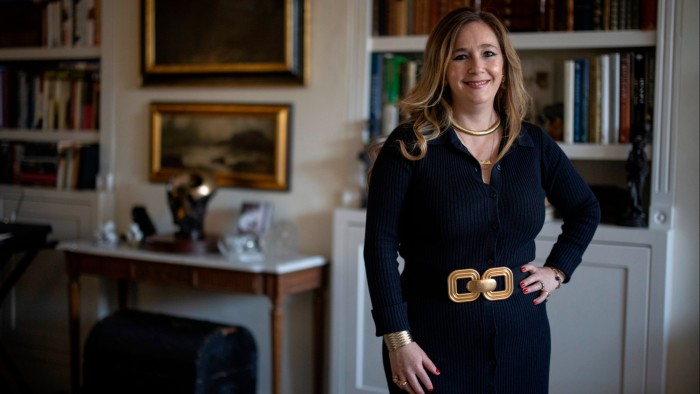In the movie Breakfast at Tiffany’s, Audrey Hepburn’s Holly Golightly and George Peppard’s Paul Varjak visit the Fifth Avenue store with only $10 to spend. A kind sales assistant, played by John McGiver, suggests a sterling silver telephone dialler for “$6.75, including federal tax” offering them a gateway into the jeweller’s exclusive sphere.
Tiffany & Co pioneered selling decorative objects alongside its jewellery in the late 19th century. The American brand, now owned by LVMH, has been able to offer more affordable items while retaining prestige and desirability, as exemplified in Blake Edwards’ 1961 classic film.
Today, some jewellers are adopting a similar approach, expanding into homeware and fashion goods to attract clients at different price points. Whether it’s the stratospheric rise in the price of gold or a desire to create a broader lifestyle experience for their clients, companies see it as a savvy move.
Emma de Sybel, vintage dealer and founder of Baroque Rocks in London, has faced the challenge of higher gold prices affecting her clients’ spending. She started selling mixed-metal items, such as a vintage gold pendant on a silver necklace, but wanted to find a pivot while staying on brand. She decided to add leather goods to her collection. “Vintage fine jewellery is a high-ticket purchase, and a luxurious frippery such as leather jewellery bag or small handbag effectively provides a more attainable entry point for our customers,” de Sybel says. She notes that this follows the strategy of big fashion houses whose smaller luxury items target a wider consumer base.
For New York-based Milton Pedraza, the chief executive of the Luxury Institute, there is a delicate balance to strike when a high-end brand diversifies its offering. “The most pristine and prestigious products must maintain a high aura, and [the brand] cannot go into trivial categories,” he says. The less expensive items can play the role of an “elevator” into fine jewellery, Pedraza points out, as long as the level of execution is excellent.
Camille Zarsky, founder of The Seven in New York’s West Village showcases homeware, such as porcelain plates, alongside jewels in her boutique. “They are less intimidating products that feel more approachable and easy to self-purchase,” she notes. “They are part of the overall story because some of these collections are great for displaying jewellery in our store and inside a home.”
For their decorative collections, a number of jewellery brands have mastered the equilibrium between accessibility and rarity while successfully retaining their DNA.
Brazilian designer Silvia Furmanovich expanded into home ornaments — from mirrors and picture frames to vases and side tables, with prices that start at $700. The move enabled the company to reach new audiences.
Keeping the small-batch production and meticulous craftsmanship of her jewellery lines was key, she says. “Each piece is handcrafted using rare woods and intricate marquetry techniques, ensuring that even at a wider range of price points, every object retains the uniqueness and artistry that define our brand.”
Home objects are a natural extension of the jewellery signature style at Seaman Schepps, too. Founded in 1904, the American brand features unusual and exotic materials such as rare woods, baroque pebbles of precious stones and natural shells in its jewels. A few years ago, the company, which has salons in New York, Palm Beach and Nantucket, introduced the Schepps Home collection, with prices ranging from $750 to $15,000.
Items include rock crystal pots and saucers, black obsidian and jade clocks, and boxes made out of hand-carved stones. For owner Anthony Hopenhajm, “These objects could only be produced in a workshop with decades of experience working with precious hard stone and gold.”
When decorative objects are not handmade in-house, jewellers source exclusive goods that align with their brand’s vision. For its marble pieces, Marlo Laz works with local artisans in Carrara’s quarries in Italy. Murano glassware is crafted using traditional methods, with founder Jesse Marlo Lazowski selecting each design.
Jewellery and homeware are intimately connected. “We have the Venetian Heart collection, and I love that we can also bring Venice — specifically Murano — into our collectors’ homes through our home goods,” she says. Marlo Laz’s decorative items, whose prices range from $180 to $550, are seamlessly showcased throughout her two New York stores.
“A few bracelets may be displayed on our jewellery tray and heart dish inside the display case and the heart dishes are also used for snacks in the store to demonstrate their multipurpose use,” Lazowski says.
Jewellers also see home decor as a way to offer a deeper connection to their artistic universe. FoundRae, known for its symbolic 18-carat gold pieces, launched the Vertu collection five years ago, initially with glassware, adding plates, candle holders and book ends over time. Prices go from $65 for a miniature plate to $2,900 for a mirror.
“Anything that we make we consider an heirloom — whether its jewellery or Vertu, each piece is carefully designed and crafted to be passed down from one generation to another,” says FoundRae founder and creative director Beth Hutchens.
FoundRae recently launched at Liberty department store in London, but its decorative objects are only available at the Miami and New York boutiques and online.
Read the full article here

